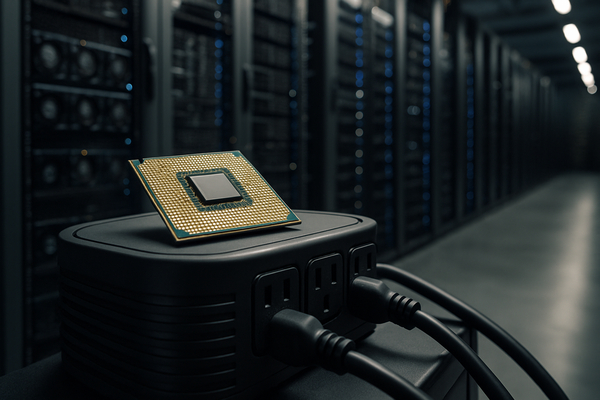
AI infrastructure boom, capital is flooding into chips, power, and racks as buyers lock in supply years ahead. New OpenAI tie-ups with NVIDIA (NASDAQ:NVDA) and Advanced Micro Devices (NASDAQ:AMD), Oracle’s (NYSE:ORCL) multibillion cloud push, and hyperscaler spend at Microsoft (NASDAQ:MSFT) and Amazon (NASDAQ:AMZN) are accelerating orders now. In the short term, a U.S. Senate move to curb AI chip exports to China and fresh tariff threats are knocking sentiment and complicating demand visibility. In the long term, sovereign and enterprise AI, HBM memory, and custom silicon keep the buildout on a multi‑year track. Globally, Taiwan Semiconductor Manufacturing (NYSE:TSM) capacity and Asia packaging flow into U.S. and European data center expansions. Unlike past cycles, this surge is pulling in power and cooling suppliers as bitcoin miners pivot to AI and utilities add generation. It matters now because procurement is happening today while policy risk rises on both sides of the Pacific.
Compute is scarce, orders are booked, and money is looping through AI
Investors heard it straight: customers are lining up years in advance for accelerators. Bernstein’s Stacy Rasgon said the reported NVIDIA–OpenAI $100 billion deal signals a shortage of compute, and that buyers are reserving capacity far out. Cantor Fitzgerald reiterated Overweight on NVIDIA with a Street‑high $300 target, arguing AI demand proves it is not a bubble. Meanwhile, Bank of America flagged strong AI ramp visibility at AMD after a call with management, as AMD shares spiked on its OpenAI processor deal.
The financing is circular. A recent chart popularized by Morgan Stanley shows capital flowing from chipmakers into AI platforms that, in turn, buy more chips. That loop is fueling near‑term bookings even as skeptics warn about longer‑dated monetization. Still, NVIDIA’s fast‑growing sovereign AI business and customers’ multi‑year commitments point to sustained demand beyond headline‑grabbing pilots.
Foundry, packaging, and memory are the choke points
On the supply side, Taiwan Semiconductor Manufacturing (NYSE:TSM) is guiding to strong Q3 FY2025, with one analysis saying tariff threats look overblown versus its backlog. KeyBanc lifted Broadcom (NASDAQ:AVGO) on CoWoS advanced packaging momentum and rising custom AI chip demand, while multiple notes called TSMC a “genius” way to play the AI upcycle into 2026.
Memory is the other bottleneck. Industry research pegs the High Bandwidth Memory market growing from roughly $3 billion in 2024 to more than $16 billion by 2033, reflecting AI’s insatiable need for bandwidth. Micron (NASDAQ:MU) sits squarely in that lane. The takeaway: capacity for CoWoS, HBM, and substrate remains the gating factor, centering critical activity in Taiwan and broader Asia, even as onshore efforts expand.
Racks, power, and cooling are the quiet winners of the AI boom
AI demand is not just about chips. It is rewriting the data center bill of materials.
- Vertiv (NYSE:VRT) drew fresh price target hikes as it rolled out Open Compute Project‑aligned rack, power, and cooling gear for high‑density AI clusters.
- Arista Networks (NYSE:ANET) keeps notching highs on AI networking demand, while Celestica launched 1.6TbE switches targeting AI and ML fabrics.
- Dell Technologies (NYSE:DELL) rallied on a swelling AI server backlog, with analysts calling for a long runway as enterprises modernize.
- Applied Digital reported a big revenue surge, and IREN (NASDAQ:IREN) signed multi‑year contracts for 11,000 NVIDIA Blackwell GPUs, underscoring bitcoin miners’ pivot into AI cloud. Bernstein said miners’ grid access and high‑density sites give them an AI advantage.
- Honeywell (NASDAQ:HON) partnered to deliver AI‑driven power management for data centers as operators chase efficiency.
The power story is as important as the silicon. Vistra (NYSE:VST) announced a 20‑year deal to supply 1,200 MW of carbon‑free nuclear output to a large investment‑grade customer and is expanding Texas capacity. NRG Energy (NYSE:NRG) drew rising targets tied to datacenter growth. Gas turbine makers like GE Vernova (NYSE:GEV) are reporting surging orders as AI drives electricity demand higher. Together, these moves address today’s interconnection backlogs and tomorrow’s load curves.
Policy shocks are the swing factor in the near term
Geopolitics just reasserted itself. Reports that the U.S. Senate advanced legislation forcing AI chipmakers to prioritize domestic buyers over China hit AMD and NVIDIA shares. Separately, traders flagged higher scrutiny of U.S. semiconductors at China customs. Qualcomm (NASDAQ:QCOM) fell after Beijing opened an antitrust probe tied to its Autotalks deal. And renewed tariff threats roiled broader semis, with the Philadelphia Semiconductor Index sliding as headlines hit.
None of this negates the structural buildout. It does change the slope of the ramp. Export rules can shift mix, complicate China channel checks, and reorder near‑term shipments. Foundry geo‑concentration remains a risk. The operational response so far: buyers diversify suppliers, pre‑pay for capacity, and pull forward orders to de‑risk timelines.
What to watch next across the stack
For operators and investors tracking the AI buildout, a few markers matter more than the daily tape:
- Capex trajectories and commentary at hyperscalers and key vendors. Microsoft says margins can hold despite higher AI capex, and Oracle is leaning into a projected $35 billion spend push and an “AI World” showcase.
- Lead times for advanced packaging and HBM. Any easing would unlock shipments downstream.
- Power interconnection queues and long‑term offtake. Vistra’s nuclear PPA and utility updates at NRG hint at how power scarcity is being solved.
- Network and facility buildouts. Vertiv, Arista, Celestica, and Dell updates are real‑time reads on rack density and thermal design wins.
- Policy headlines. Export licenses, customs checks, and tariff rhetoric can swing quarterly flows even if the multi‑year demand curve stays intact.
The AI infrastructure boom has moved past concept and into procurement. Short term, export controls and tariffs will keep injecting volatility. Long term, the stack from chips to power is widening to meet global AI demand, with Asia’s foundries, America’s utilities, and Europe’s regulators all in the frame. This cycle reaches far beyond GPUs, and that breadth is why the build continues even as headlines jolt the market.












